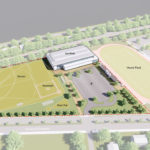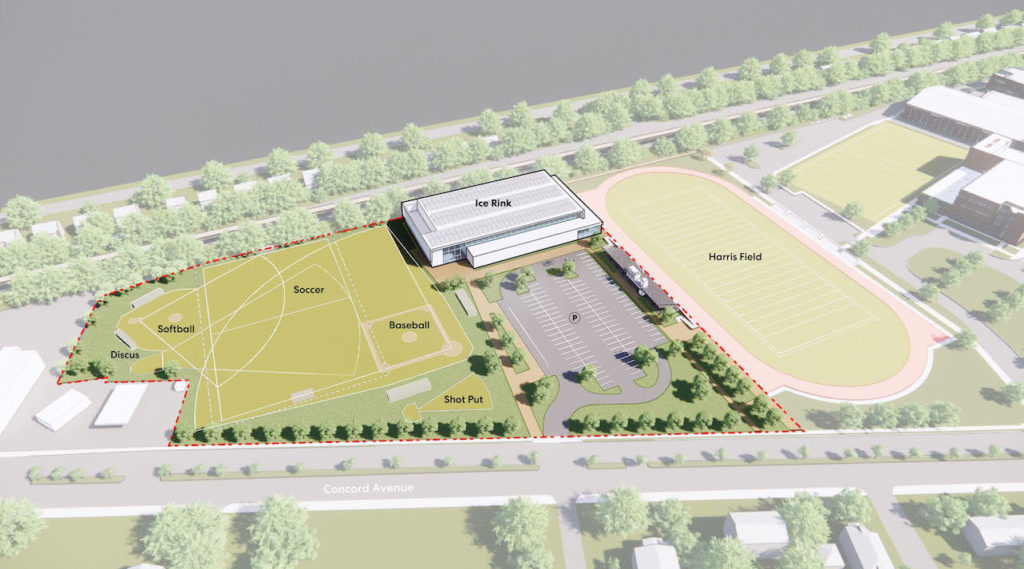
To the BCF editor:
Anne Paulsen’s recent column [“Do We Need a High School Parking Lot?” BCF Newsletter, July 2022] argued that if parking were eliminated west of Harris Field, then there would be “plenty of room for tennis courts and some open space as well.”
Whether tennis and a rink could both fit has been studied intensively by numerous informed parties: the High School Building Committee, a sports architect from Perkins+Will, rink architect Ted Galante, the Select Board, the School Committee, and the Preliminary Rink Design Committee.
None of these efforts found a layout that could accommodate a rink, 110 parking spaces, and five tennis courts at ground level. The architects made concept sketches with elevated tennis courts, either on a deck above a parking area (Perkins+Will) or on a rink roof (Galante). Elevated courts would cost approximately $5 million.
Anne says eliminating the parking would make room for a rink and five courts. But she makes a mistake that kills her argument.
She writes that a tennis court is 2,106 square feet and that the total space requirement for five courts would be “just under 11,000 square feet.” Not true. Five regulation tennis courts require at least 30,240 square feet. That mistake changes everything.
If you leave the rink in its current location and take down the White Field House, you couldn’t nearly fit five tennis courts between the rink and Concord Avenue. Moreover, a new rink needs to be larger to replace some of the capacity of the Field House, which leaves less space for courts.
Anne also fails to consider that a rink requires a driveway and vehicle access from Concord Ave even without a parking lot. That also reduces space for tennis courts.
A rink fronting on Concord Avenue perhaps could leave space behind for tennis courts but there has been no support for this approach from the residents and our public safety officials also do not recommend this layout. Galante determined that a rink set back by the tracks is not workable.
One could fit tennis with a rink by reducing the other playing field space west of Harris Field, which is not acceptable to the School Committee.
When you consider the actual size of five tennis courts and the realities of the site, the choice is really between a rink or tennis, or a large cost to elevate the courts to have both. Anne’s assumptions about eliminating parking do not provide a solution.
Roy Epstein
Member of Select Board, Town Meeting Member, Precinct 6
Paulsen responds:
To respond to Mr. Epstein’s letter about my article in the July/August BCF Newsletter, I would say that Mr. Epstein missed the underlying theme of the article: “What is the best use of limited space in a small community?”
It is true that I used the square footage of the courts themselves and did not include the surrounding area, but the Perkins+Will presentation to the School Committee last January showed the rink in an east/west position with a 110-space parking lot in front. Tennis courts were on top. Since a parking lot of 110 cars consumes about 30,000 square feet, the same as five full tennis courts, take away the parking lot, lower the tennis courts, and voila! I continue to think that tennis courts are a better use of space than a parking lot.
Mr. Epstein, in his eagerness to “kill” (such a violent term in this day and age) my argument, never reveals his position on how to make the best use of limited space. He now supports the latest design of the rink project presented by a new architect that keeps an expanded rink in its present location, a location which slightly increases field space but prevents any new uses except for one: some expanded parking and an off-street drop-off.
The proposed design shows additional parking by extending the jug handle lot along Concord Avenue almost to the entrance to the football area along with a sweep of pavement to allow a drop-off at the rink door. This can add about 30 more spaces. While being constructed as part of the rink project, it will also allow for more off-street student parking.
Mr. Epstein has expressed support for this expanded parking. But at what cost? It will require the elimination of mature shade trees and leave the three houses across the street with a roadway and parking lot in front instead of a view dominated by shade trees.
I know that Mr. Epstein has supported ”no parking during certain hours” on streets across from the Belmont Middle and High School so no students will park on these side streets. Is it fair to champion no parking on some streets and then support an expansion of off-street parking in front of other people’s houses?
Parking lots are hot spots. We are reminded this summer why we do not need any more hot spots. Parking lots are dirty and the runoff lands in streams and rivers. Expanding parking along Concord Avenue will reduce the shade canopy and make the neighborhood hotter and less pedestrian friendly.
Furthermore, as I stated in my article, Myrtle Street has parking on one side of the street halfway up and then changes to the other side for the rest of the street. It does not prevent parking but does prevent cars from narrowing the street and making it unsafe for moving vehicles. This has been a major concern of the neighbors affected by high school parking. Since the new “no parking during certain hours” does not extend to Myrtle Street and Cottage Street, residents on these streets will now bear the burden of student parking while other streets are parking free.
The town, which is supporting solar energy and trying to meet zero-net energy goals, should not be in the business of creating more off-street parking, which adds to the warming of the atmosphere. We can develop bylaws and regulations that protect the natural resources and discourage environmental degradation. We should not cut down shade trees for convenience.
Efficient use of street parking preserves land. We already have public streets that can accommodate parking, and we can develop rules that prevent unsafe parking, but we, as residents, should view the streets and street parking as shared resources, not as private spaces.
The school system must work with the town and with the students and parents to discourage driving to school. Can we rethink our school bus use and rates? Right now it is probably cheaper to drive to school than take the bus.
Every school can take steps to inform parents of the dangers of unsafe parking on our streets during school hours and especially at drop-off and pickup times and work with surrounding neighbors to make our school zones safer.
There are ways to reduce the impact of cars in our neighborhoods, but expanding any off-street parking is not one of them.
Anne Paulsen



Sorry, the comment form is closed at this time.